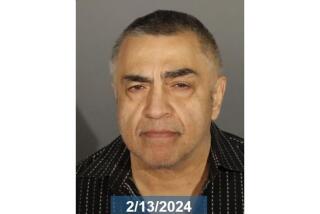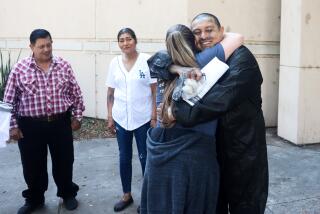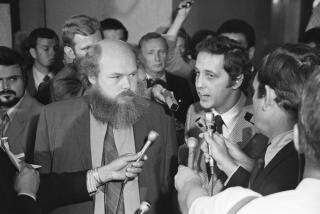A ‘Routine’ Death Starts the Trail to a Murder Case
- Share via
The death of Ellis Henry Greene in a doctor’s office last April was so apparently unremarkable that it almost passed into history as unnoticed as Greene himself.
A rootless Ohio native, Greene disappeared one night on his way from one North Hollywood bar to another. Even though Greene was dead, his name later made its way into the vast file of missing persons whose cases are never solved.
When the doctor, Glendale neurologist Richard P. Boggs, turned Greene’s body over to the county coroner, he identified the corpse as someone else. And no one noticed.
Quest to Solve Mystery
It was only two months later, and then by chance, that Greene’s death emerged as the main element in an alleged million-dollar insurance scam, leading law enforcement investigators from across the country on a seven-month quest to solve the mystery of the drunken man’s last nine hours. It took them three months to fix Greene’s identity, and four more to build a case against the doctor.
The effort culminated last week in Boggs’ arrest outside his Glendale office as the Los Angeles County district attorney’s office filed murder, conspiracy and insurance fraud charges against the doctor and two Ohio businessmen.
Authorities allege that Boggs conspired with two founders of a failing Midwest apparel firm to kill Greene and use his body to collect $1 million in life insurance.
At his arraignment Monday, Boggs pleaded not guilty. Afterward, Deputy Dist. Atty. Al MacKenzie revealed that the investigation had produced evidence of a possible second murder committed by Boggs. He said investigators were preparing to produce as many as 100 witnesses to piece together the complex story for a jury.
Yet it was a case that nearly eluded law enforcement. From beginning to end, breakthroughs were won by the routine, and sometimes inglorious, work of people outside the official investigation.
The first was an insurance claims representative who made a routine follow-up call to double check her information. Without the call, Greene’s death would never have been discovered, authorities acknowledge. A key clue was turned up by a private investigator scouring a couple of bags of trash. Then, last week, two U.S. Customs agents in Texas snared one of the key suspects by singling out a homebound tourist whose appearance aroused their suspicions.
Unknown to the Customs agents, the man they detained was Melvin E. Hanson, 48, who was supposed to be dead. A body, identified as Hanson’s but actually Greene’s, had been cremated. Hanson’s 25-year-old partner and sole heir, John B. Hawkins, had collected the life insurance.
Although prosecutors declined to say how they believe Greene was killed, they concede that the deceptively simple plan exploited a gaping loophole in the system for handling the dead. The key ingredient was a corpse that showed no evident signs of foul play, MacKenzie said.
Four Main Figures
Beyond that, the four main figures in the case were well suited to diffuse suspicion. Boggs, a 1961 graduate of Loma Linda University, had maintained an unblemished practice. Hanson and Hawkins appeared to be riding high as founders of a thriving business. And Greene was just shadowy enough that his disappearance provoked no major search.
Authorities speculated that it would have worked perfectly except for the call placed June 9 by a representative of Farmers New World Life Insurance Co. of Mercer Island, Wash., to the Glendale police. The company was already in the process of paying out two $500,000 policies on Hanson’s life, and the claims worker, whose name the company is not releasing, was merely asking for a status check on police reports, a Farmers’ spokesman said.
The claims worker happened to ask whether the police had checked the photo of corpse against that of the policy holder. They had not.
The death that occurred in a drab medical building on North Central Avenue had been odd, but not extraordinary.
Boggs, 55, called paramedics on April 16, reporting that a patient had died in his office of apparent heart failure. He told authorities the dead man was Hanson, a patient who had been coming to him for seven years during business trips here.
According to police reports, Boggs said Hanson left a message on the doctor’s home answering machine that morning saying he had been drinking heavily, was short of breath and felt pressure on his chest.
Boggs said he met Hanson at 5 a.m., made an electrocardiogram, left him a moment and then heard a thump. He said the patient was dead by the time he got through to someone on the emergency line.
Two patrolmen, sensing something unusual, called in coroner’s investigators. An autopsy uncovered no signs of foul play and attributed the death to inflammation of the heart. A toxicological test showed very high levels of alcohol in the dead man’s blood. Luckily, it would later turn out, the coroner took a snapshot of the corpse and made fingerprints. Without them, the prosecutor said, there would be no case.
Hawkins, Hanson’s partner in the Columbus-based athletic clothing firm, Just Sweats Inc., quickly arrived to claim the body and have it cremated.
Both Boggs and Hawkins said the dead man was Hanson. Credit cards and a photocopy of a birth certificate found in his wallet identified him so. Neither the coroner nor Glendale police sought further proof.
That was the last seen of Hanson, at least under that name, until his arrest last Monday. Hawkins returned to Columbus, where he resumed his life as a young, successful businessman.
Just Sweats Inc., which Hanson and Hawkins started in 1985, had grown to 22 outlets, was generating $8.5 million in annual sales and was named by Entrepreneur Magazine as an “Opportunity of the Month,” according to the Wall Street Journal. In spite of the image, however, the company could not pay its creditors.
When Hawkins disappeared suddenly in mid-July, leaving his Mercedes-Benz convertible at the airport with its top down, Columbus Police Detective James Lanfear investigated. Lanfear concluded that Hawkins had siphoned $1.8 million from the firm. It has since declared bankruptcy. Hawkins has not been found.
Just before he vanished, Hawkins received two checks for $1 million in the mail from Farmers New World Life.
By then, the insurance claim caper was beginning to unravel. In response to the insurance company’s inquiry, a Glendale investigator ordered a photograph of Hanson from the Department of Motor Vehicles.
When Hanson’s photo arrived, the differences were not overwhelming, but one face appeared older than the other. A thumbprint was ordered from the DMV. Its arrival--only days after the insurance was paid--was conclusive. Someone other than Hanson had died.
Investigation Widens
The investigation then widened to involve police and prosecutors in Los Angeles and Columbus, the California Department of Insurance fraud bureau and the FBI. Although Boggs was a suspect, the outlines of the crime remained fuzzy because there was no known victim.
On Sept. 29, the Department of Insurance found the victim in the U.S. Department of Justice computer file of missing persons. A fingerprint comparison established the dead man as Greene, a 32-year-old native of Portsmouth, Ohio. Greene had moved to Los Angeles four years earlier and may have known Hanson or Hawkins. Greene’s aunt, who filed the missing person report, confirmed the identity by photo.
Within days, local authorities opened a homicide investigation. In searching Boggs’ office and home, the Department of Insurance found equipment for manufacturing illegal drugs as well as a stun gun, a weapon that disables its target with an electric charge, Deputy Dist. Atty. MacKenzie said. The stun gun is being investigated as a possible murder weapon, he said.
Despite the tightening circle, Boggs kept his practice current. He told The Times that he believed he was duped by Greene, who, Boggs said, had represented himself as Melvin Hanson throughout the seven years of their association. And that will be his defense, according to his attorney.
However, in the charges against Boggs, the prosecutor detailed numerous phone calls between Boggs, Hanson and Hawkins, both before and after Greene’s death.
Unanswered Questions
Many questions are yet to be answered. Authorities have not divulged how Greene got into Boggs’ office after he left a gay bar called the Bullet Club the night of his death. They will not say how the Glendale doctor developed a relationship with the two Ohio businessmen.
It is known, however, that a key clue that led to Hanson’s Jan. 29 arrest, precipitating the unfolding of the case, was picked from a trash bag in Columbus.
Shortly before Greene’s identity was found, the insurance company, seeking to speed the investigation, hired Vincent Volpi of the Columbus office of PICA Inc., a firm that specializes in investigating fraud.
Volpi said he got onto Hanson’s trail by picking through two bags of trash left in front of the condominium Hawkins had hastily vacated in July. It was still occupied by his former roommate. A number on a phone bill led Volpi to a Miami condominium rented to a Wolfgang E. Von Snowden.
Volpi said he was told in Miami that Von Snowden was really Hanson. He also learned that Hanson had paid a Miami plastic surgeon several thousand dollars to take 20 years off his face. Hanson was reported to be in the Florida Keys, Volpi said.
Files Criminal Charges
The Franklin County, Ohio, prosecutor’s office filed criminal grand theft charges against Hanson and Hawkins, leading to the issuance of a federal fugitive warrant. Hanson was not found in the Florida Keys, however.
Volpi said he succeeded, with the help of a former employee then working for the U.S. Customs Service, in having the alias Von Snowden added to Hanson’s records in the Treasury Enforcement Communications System. That became the key to Hanson’s arrest.
When Hanson got off a plane from Acapulco last week at the Dallas-Ft. Worth airport, he presented the identification of a man named Soule. He probably could have passed into the country anonymously along with the other returning tourists, had not two agents found his behavior suspicious, said David Greenleaf, Customs Service district supervisor for Dallas-Ft. Worth.
Greenleaf said Agents Dave Berry and Jim Starnes spotted Hanson, wearing red shorts and tennis shoes, at the baggage carrousel and thought he looked too nervous and too much in a hurry to be a tourist.
Berry asked a few questions and decided to search Hanson’s hand luggage. He was carrying $14,000 in cash--which Hanson had not declared--and diverse pieces of identification under several names. Among them was a birth certificate for a Wolfgang von Snowde. That name produced a warrant on the computer.
Hanson waived extradition to Ohio, where the county prosecutor’s office is preparing embezzlement and insurance fraud charges against him and Hawkins.
During his stay in a Texas jail cell reserved for men who say they are homosexual, Hanson reportedly became a quick celebrity among the other inmates and showed a sense of humor about it all.
The Columbus Dispatch reported that when he was asked if he could make his $5 million bail, Hanson replied: “If they let me die a few more times, I can.”
He may get at least one more shot.
Either before or after his trial in Columbus, authorities will seek to extradite Hanson to Los Angeles for trial on the murder charge. Because of a special allegation of murder for financial gain, the penalty is death.
Times staff writer Edwin Chen contributed to this article.
More to Read
Sign up for Essential California
The most important California stories and recommendations in your inbox every morning.
You may occasionally receive promotional content from the Los Angeles Times.











